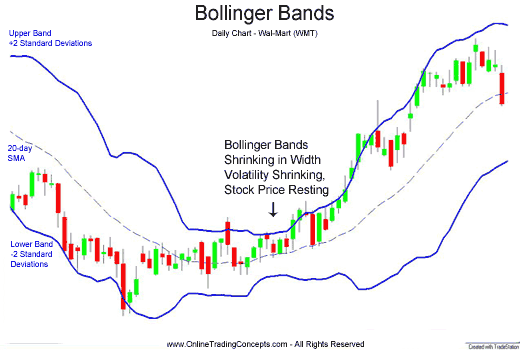Trading with Bollinger Bands (R)
Post on: 5 Июль, 2015 No Comment

The Bollinger Bands will bracket price action. In times of high volatility, they widen, while in times of low volatility, they move closer together. So basically, they adjust to the movement and volatility of the market. This extra volatility filter is the real value of this tool.
There are two conditions we look for in a trading opportunity. We want to buy a pullback down to support when the market is in an uptrend or sell a rally up to resistance when the market is in a downtrend. The Bollinger Bands typically offer good resistance and support for our trade setup, so we just have to make sure we are following the strong trending pairs.
Lets look at an example on this USDCHF daily chart.
Created by FXCM Marketscope Charts 2.0
The trend is up as we can see a series of higher highs and higher lows, which means to look for a dip down to support (the lower band) for a buying opportunity. I have two examples noted on the chartthe first took place in May and the second took place in June of this year. The market traded down to the lower Bollinger Band in each of the instances noted in the boxes. However, this is not necessarily the buy itself but rather just the signal to begin to look for a buy on a reversal.
Traders will use a variety of methods to determine the entry, ranging from using their favorite indicator to just buying as the market moves up through the previous high. One popular approach is to buy on the first candle that closes above the middle linethe 20-day Simple Moving Average. This serves as more confirmation of the reversal and increases our chance of success on the trade. (On the chart above, the buy candle is identified by a green arrow.) Traders could then place their protective stop below the lowest wick in the box and look for twice that risk in profit for a 1:2 risk:reward ratio.
I would like to mention that price action on the USDCHF moved down and touched the lower Bollinger Band four times over the last several days. This means we should be on the lookout for another buying opportunity.
But rather than just buying right now, this would be the time to use your approach to pinpoint that buy entry to increase your chance of success on the trade. Price has moved up since the lower band was tested last week. By exercising patience and discipline and waiting for that first close above the 20-day Simple Moving Average would be a way to enter this trade using the Bollinger Band strategy that you just learned.
New to the FX market? Save hours in figuring out what FOREX trading is all about.
Take this free 20 minute New to FX course presented by DailyFX Education. In the course, you will learn about the basics of a FOREX transaction, what leverage is, and how to determine an appropriate amount of leverage for your trading.
Registe r HERE to start your FOREX trading now!
DailyFX provides forex news and technical analysis on the trends that influence the global currency markets.
Learn forex trading with a free practice account and trading charts from FXCM.














